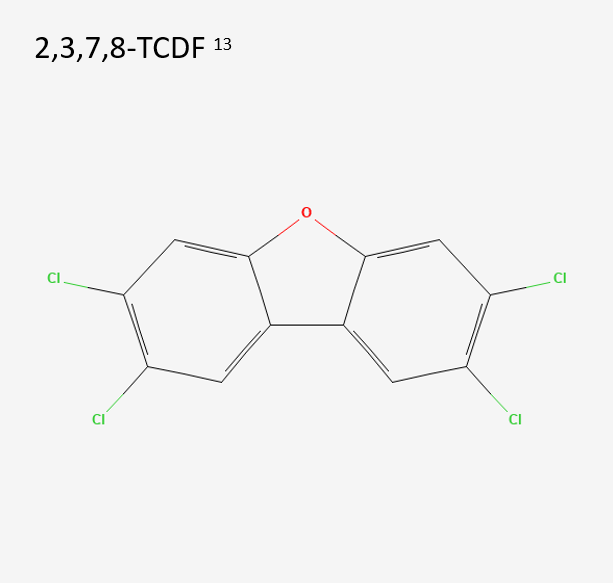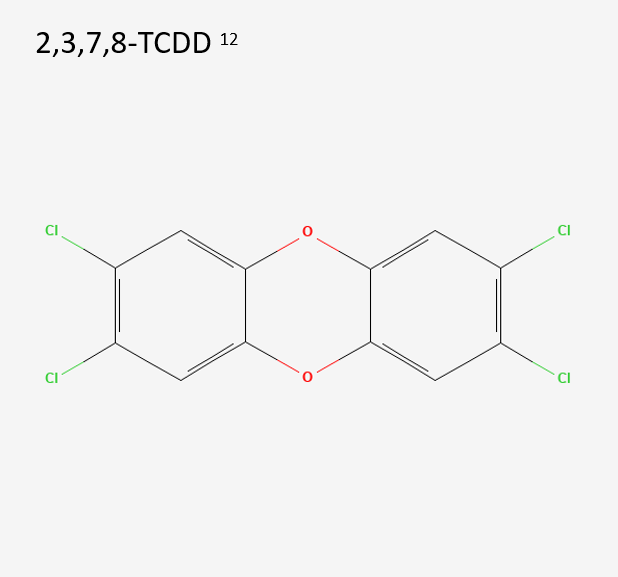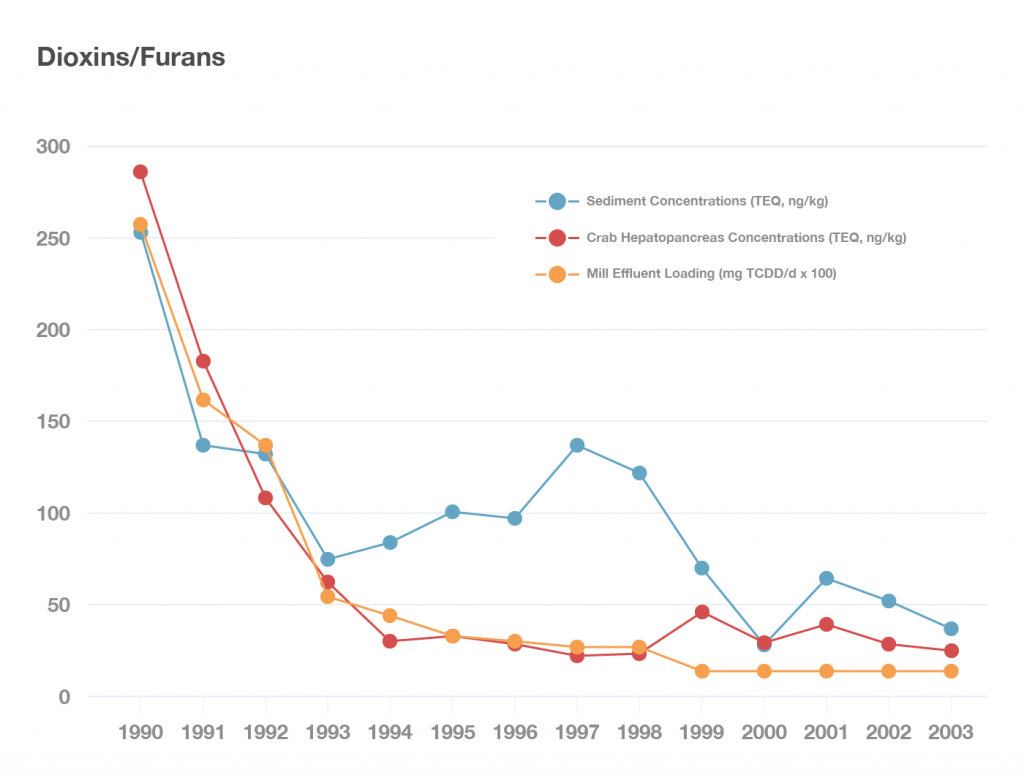SedimentPCDD/Fs (ng TEQfish/kg dry weight)
|
MusselsPCDD/Fs (ng TEQmamm/kg wet weight)
|
|
|---|---|---|
|
|
North |
|
| South |
What are they?
Polychlorinated dibenzo-p-dioxins (PCDDs or dioxins) and polychlorinated dibenzofurans (PCDFs or furans) are produced unintentionally as by-products of industrial processes such as the combustion of waste products and the manufacture of pesticides and other chlorinated substances. They are also emitted from vehicles, the burning of salt-laden wood in coastal pulp and paper boilers, and in wood treatment.

How do they get into the ocean?
In British Columbia (BC), pulp and paper mills historically released large amounts of dioxins and furans into the marine environment. Wood treatment by chlorophenol-based chemicals was also a major source of dioxins and furans to the marine environment; however, the use of these products has declined.
A current source of dioxins and furans to the BC environment is the burning of salt-laden wood at pulp and paper plants. The salt in the wood contains chlorine, which, when burned, can result in the production of dioxins and furans.
FACT: PCDDs and PCDFs are highly toxic compounds that were formed inadvertently as by-products of the bleaching process at pulp and paper mills. Regulations in 1989 in Canada led to a 95% reduction in the release of these compounds in coastal BC.2
Are they a problem?
Dioxins and furans are part of a group of pollutants known as persistent organic pollutants (POPs) under the Stockholm Convention on Persistent Organic Pollutants. Of the 75 different dioxins and 135 furans, seven dioxins and ten furans are considered to be of particular concern.1
Dioxins and furans have been associated with a number of adverse effects in humans, including immune and enzyme disorders, effects on reproductive function, and cancer. 1,3 They are also persistent in the environment and can bioaccumulate in tissues. 3,4 Diet is the primary exposure route in humans.4

Studies in salmon have shown that the use of lipid reserves during migration results in increasing concentrations of dioxins and furans in tissues. 5,6 Dioxin and furan concentrations measured in the eggs of migrating salmon were high enough to cause egg mortality 5,6, and the authors suggested that dioxin/furan levels in salmon may have contributed to the decline of some salmon stocks.
Mammals exposed to TCDD, a highly toxic PCDD, can experience increased mortality, reduced growth, reproductive impairment, fetal abnormalities, immune system suppression, and cancer. 7
What is being done?
In 1989, federal regulations were introduced that restricted the use of elemental liquid chlorine in pulp and paper mills, reducing overall inputs of PCDDs by over 90%. 2,7 For example, loadings of the most toxic PCDD (TCDD) have decreased by over 98% since 1992. 7 As a result, pulp and paper mill effluent is no longer considered a major source of PCDDs to the marine environment.
Canada-wide standards have been developed by the Canadian Council of Ministers of the Environment (CCME) for pulp and paper plants burning salt-laden wood, and wood treatment facilities face much more stringent pollution control measures. These steps have resulted in decreases in dioxin releases. 7 PCDDs are slated for virtual elimination under the Canadian Environmental Protection Act, the Federal Toxic Substances Management Policy, and the CCME Policy for the Management of Toxic Substances.
Canadian Sediment Quality Guidelines protective of marine aquatic life are available for PCDD/DFs, and these guidelines have been adopted in British Columbia (Table 1).
Table 1. Federal and Provincial Marine Sediment and Tissue Guidelines for PCDD/DFs 10,11
Globally, the Stockholm Convention on Persistent Organic Pollutants requires countries to reduce emissions of dioxins and dioxin-like substances.

What can you do?
As individuals and organizations we can:
- Learn more about PCDD/Fs and other contaminants of concern using the resource links below
- Recycle and dispose of waste responsibly
- From Health Canada 9:
- Don’t burn garbage, especially construction materials that might contain wood preservatives or plastic
- Follow provincial/territorial government advisories about eating certain types of fish and seafoods
More Information?
1 Srogi, K. 2008. Levels and congener distributions of PCDDs, PCDFs and dioxin-like PCBs in environmental and human samples: a review. Environmental Chemistry Letters 6: 1-28.
2 Hagen ME, Colodey AG, Knapp WD, Samis CS. 1997. Environmental response to decreased dioxin and furan loadings from British Columbia coastal pulp mills. Chemosphere 34 : 1221-1229.
3 World Health Organization (WHO). 2010. Exposure to dioxins and dioxin-like substances: A major public health concern. World Health Organization. Geneva, Switzerland. 6 p.
4 Domingo JL, Bocio A. 2007. Levels of PCDD/PCDFs and PCBs in edible marine species and human intake: A literature review. Environment International 33: 397-405.
5 Kelly BC, Gray SL, Ikonomou MG, MacDonald JS, Bandiera SM, Hrycay EG. 2007. Lipid reserve dynamics and magnification of persistent organic pollutants in spawning sockeye salmon (Oncorhynchus nerka) from the Fraser River, British Columbia. Environmental Science and Technology 41: 3083-3089.
6 DeBruyn AMH, Ikonomou MG, Gobas FAPC. 2004. Magnification and toxicity of PCBs, PCDDs, and PCDFs in upriver-migrating Pacific salmon. Environmental Science and Technology 38: 6217-6224.
7 Garrett C and Ross PS. 2010. Recovering resident killer whales: A guide to contaminant sources, mitigation, and regulations in British Columbia. Canadian Technical Report of Fisheries and Aquatic Sciences 2894: xiii + 224 p.
8 British Columbia Ministry of Environment, Fisheries and Oceans Canada, University of Victoria, University of British Columbia, and Environment Canada. 2006. Alive and Inseparable: British Columbia’s Coastal Environment. British Columbia Ministry of Environment. Available at: CME-inside-REVISED.indd (gov.bc.ca)
9 Health Canada. 2001. It’s Your Health. Dioxins and Furans. Available at: https://www.canada.ca/content/dam/hc-sc/migration/hc-sc/hl-vs/alt_formats/pacrb-dgapcr/pdf/iyh-vsv/environ/dioxin-eng.pdf
10 Canadian Council of Ministers of the Environment (CCME). 2001. Canadian sediment quality guidelines. Canadian Council of Ministers of the Environment, Winnipeg. Available at: http://ceqg-rcqe.ccme.ca/en/index.html#void
11 British Columbia Ministry of Environment and Climate Change Strategy. 2021. Working Water Quality Guidelines: Aquatic Life, Wildlife & Agriculture. Water Quality Guideline Series, WQG-08. Prov. B.C., Victoria B.C. Available at: https://www2.gov.bc.ca/assets/gov/environment/air-land-water/water/waterquality/water-quality-guidelines/bc_env_working_water_quality_guidelines.pdf
12 PubChem Identifier: CID 15625 2,3,7,8-Tetrachlorodibenzo-P-dioxin | C12H4Cl4O2 – PubChem (nih.gov)
13 PubChem Identifier: CID 39929 2,3,7,8-Tetrachlorodibenzofuran | C12H4Cl4O – PubChem (nih.gov)